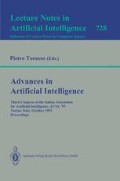Abstract
The VITAL-KR provides the basic sub-structure for integrating a number of representation and inference paradigms as a means towards experimenting in the design of hybrid systems. In this paper we give an overview of the VITAL-KR, in particular illustrating how it supports the development of hybrid applications, as well as the integration of new inference systems. We believe that the VITAL-KR provides a number of advantages over alternative hybrid AI programming environments. Its communication primitives are generic, as they do not depend on the structure of a particular knowledge representation system; it is extendible, as it provides well-defined mechanisms for integrating new inference systems; it enjoys a formal, unambigous specification; and it comprises mechanisms to ensure the consistency of the overall, hybrid KB.
Preview
Unable to display preview. Download preview PDF.
References
Allen, J.F. and Miller, B.W. (1991). The RHET System: A Sequence of Self-Guided Tutorials. TR 325, Computer Science Dept, University of Rochester, July 1991.
Brownston, L., Farrell, R., Kant, E., and Martin, N. (1985). Programming expert systems in OPS5: An Introduction to rule based programming. Reading, MA: Addison-Wesley.
Corkill, D.D. (1991). Embedable Problem-Solving Architectures: A Study of Integrating OPS5 with UMass GBB. IEEE Transactions on Knowledge and Data Engineering, 3(1), March 1991.
Cutkosky, M,. Engelmore, R., Fikes, R., Gruber, T., Genesereth, M., Mark, W., Tenenbaum, J., Weber, J. (1992). PACT: An Experiment in Integrating Concurrent Engineering Systems, 1992.
Davis, R. and Smith, R.D. (1983). Negotiation as a Metaphor for Distributed Problem Solving. Artificial Intelligence, 20(1), pp 63–109.
Domingue, J., Motta, E. and Watt, S. (1993). The Emerging VITAL Workbench. Proceedings of the 7th European Knowledge Acquisition Workshop, Toulouse, France, September 1993.
Doyle, J. (1979). A Truth Maintenance System. Artificial Intelligence, 12.
Finin, T., Fritzon, R. and McKay, D. (1992). An Overview of KQML: A Knowledge Query and Manipulation Languag, Technical Report, Department of Computer Science, University of Maryland Baltimore County, 1992.
Funt, B.V. (1980). Problem-Solving with Diagrammatic Representations. Artificial Intelligence, 13(3), pp 201–230.
Garlan, D. and Ilias, E. (1990). Low-Cost, Adaptable Tool Integration Policies for Integrated Environments, Proceedings 4th ACM SIGSOFT Symposium on Software Development Environments, Irvine, December, 1990.
Gasser, L., Braganza, C. and Herman, N. (1987). MACE: A Flexible Testbed for Distributed AI Research. In Huhns (Ed.), Distributed Artificial Intelligence, Pitman, London.
Genesereth, M.R. and Fikes, R.E. (1992). Knowledge Interchange Format, Reference Manual, Version 3.0. Technical Report, Computer Science Department, Stanford University, 1992.
Gisi, M., Kaiser G. (1991). Extending a tool integration language. Proceedings First Int. Conference on the Software Process, IEEE Computer Society Press, October 1991, pp 218–229.
Inder, R., Aylett, R., Bental, D., Lydiard, T. and Rae, R. (1990). Study on the Evaluation of Expert Systems Tools for Ground Segment Infrastructure: Final Report. TR84, AI Application Institute, University of Edinburgh.
Keene, S. (1989). Object-Oriented Programming in Common Lisp. Addison-Wesley, Reading, Massachussets.
Lenat, D.B. and Guha, R.V. (1990). Building Large Knowledge-Based Systems: Representation and Inference in the Cyc Project. Addison-Wesley, Reading, MA.
Levesque, H.J. (1984). Foundations of a Functional Approach to Knowledge Representatio. Artificial Intelligence, 23(2), 1984.
Linster, M. (1992). Sisyphus '92: Models of Problem Solving. GMD Technical Report.
Motta, E., Stutt, A., O'Hara, K., Kuusela, J., Toivonen, H., Reichgelt, H., Watt, S., Aitken, S., and Verbeck, F. (1992). VITAL Knowledge Representation Language Specification: Final Deliverable. VITAL Technical Report, OU/DD412/W/1.
Motta, E., Rajan, T., Domingue, J., and Eisenstadt, M. (1991). Methodological Foundations of KEATS, The Knowledge Engineers'Assistant. Knowledge Acquisition, 3(1), March 1991.
Neches, R., Fikes, R., Finin, T., Gruber, T., Patil, R., Senator, T. and Swartout, W. (1991). Enabling Technology for Knowledge Sharing. AI Magazine, vol 12(3).
Patil, R.S., Fikes, R.E., Patel-Schneider, P.F., Makay, D., Finin, T., Gruber, T., Neches, R. (1992) The DARPA Knowledge Sharing Effort: Progress Report, Principles of Knowledge Representation and Reasoning: Proceedings of the 3rd International Conference, Morgan Kaufmann, 1992.
Plotkin, G.D. (1981). A Structural Approach to Operational Semantic. Technical Report DAIMI FN-19, Computer Science Department, Aarhus University, Denmark, September 1981.
Reichgelt, H., and Van Harmelen, F. (1986). Criteria for choosing representation languages and control regimes for expert systems. The knowledge engineering review. 1(4).
Schreiber, G., Breuker, J., Bredeweg, B., and Wielinga, B. (1988). Modelling in KBS Development. Proceedings of the 3rd European Knowledge Acquisition Workshop, EKAW '88, Bonn.
Zhang, C. and Bell, D.A. (1991). HECODES: a framework for HEterogeneous COoperative Distributed Expert Systems. Data & Knowledge Engineering, 6, 1991.
Author information
Authors and Affiliations
Corresponding author
Editor information
Rights and permissions
Copyright information
© 1993 Springer-Verlag Berlin Heidelberg
About this paper
Cite this paper
Gaspari, M., Motta, E., Stutt, A. (1993). Inferring in lego-land: an architecture for the integration of heterogeneous inference modules. In: Torasso, P. (eds) Advances in Artificial Intelligence. AI*IA 1993. Lecture Notes in Computer Science, vol 728. Springer, Berlin, Heidelberg. https://doi.org/10.1007/3-540-57292-9_52
Download citation
DOI: https://doi.org/10.1007/3-540-57292-9_52
Published:
Publisher Name: Springer, Berlin, Heidelberg
Print ISBN: 978-3-540-57292-3
Online ISBN: 978-3-540-48038-9
eBook Packages: Springer Book Archive

